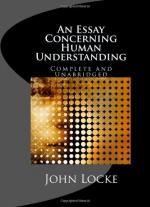3. Demonstration depends on clearly perceived proofs.
Those intervening ideas, which serve to show the agreement of any two others, are called proofs; and where the agreement and disagreement is by this means plainly and clearly perceived, it is called demonstration; it being shown to the understanding, and the mind made to see that it is so. A quickness in the mind to find out these intermediate ideas, (that shall discover the agreement or disagreement of any other,) and to apply them right, is, I suppose, that which is called sagacity.
4. As certain, but not so easy and ready as Intuitive Knowledge.
This knowledge, by intervening proofs, though it be certain, yet the evidence of it is not altogether so clear and bright, nor the assent so ready, as in intuitive knowledge. For, though in demonstration the mind does at last perceive the agreement or disagreement of the ideas it considers; yet it is not without pains and attention: there must be more than one transient view to find it. A steady application and pursuit are required to this discovery: and there must be a progression by steps and degrees, before the mind can in this way arrive at certainty, and come to perceive the agreement or repugnancy between two ideas that need proofs and the use of reason to show it.
5. The demonstrated conclusion not without Doubt, precedent to the demonstration.




